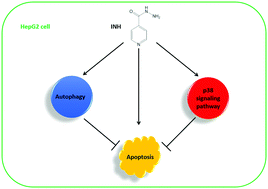Induction of protective autophagy against apoptosis in HepG2 cells by isoniazid independent of the p38 signaling pathway
Abstract
Isoniazid (INH), one of the first-line anti-tuberculosis drugs, is adversely associated with hepatotoxicity in the clinic. However, the detailed mechanism of this side effect is still unclear. The traditional theory that cytochrome P450 2E1 is involved in INH-induced hepatotoxicity remains controversial, therefore other mechanisms by which INH exerts hepatotoxicity need to be investigated. In the current study, we showed that in vitro treatment of human hepatocarcinoma HepG2 cells with INH induced caspase-dependent apoptosis through extrinsic and intrinsic pathways. It was characterized by the increased population of apoptotic cells using Annexin V/propidium iodide (PI) double staining by flow cytometry, and by the activation of caspases 8, 9, 3 and poly (ADP-ribose)-polymerase (PARP) proteins by western blotting. INH treatment also induced autophagy as shown by the upregulated levels of microtubule-associated protein 1 light chain 3-II (LC3-II), increased GFP-LC3 punctates, and elevated monodansylcadaverine (MDC) fluorescence intensity. The measurement of the autophagic flux using chloroquine (CQ) confirmed that INH stimulated autophagy but did not inhibit it by impairing lysosomal degradation. The blockage of autophagy with CQ exacerbated INH-induced apoptosis significantly. Further study showed that INH treatment down-regulated the protein phosphorylation of the mammalian target of rapamycin (mTOR), the key negative regulator of autophagy. In addition, INH induced p38 signaling activation. SB203580, a p38 inhibitor, effectively enhanced INH-induced apoptosis by increasing the cleavages of caspases 9, 3 and PARP, but did not affect autophagy. In summary, we firstly found that INH induced a protective autophagy which was associated with the inhibition of the mTOR pathway, and that INH induced p38 signaling activation to inhibit apoptosis by down-regulation of caspases 9, 3 and PARP pathways, but not that of autophagy. Thus, activation of autophagy and p38 signaling is presumably a therapeutic strategy for INH-induced hepatotoxicity.


 Please wait while we load your content...
Please wait while we load your content...